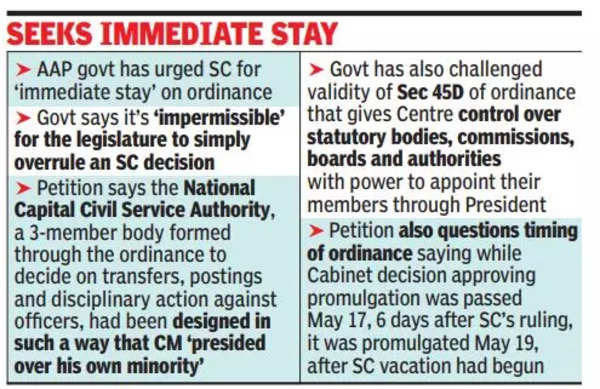[ad_1]
It has also urged the apex court to quash the Government of NCT (Amendment) Ordinance, 2023, arguing that it destroyed the federal structure of a democratic government and completely sidelined the elected dispensation from control over its civil service.The ordinance was promulgated on May 19, eight days after the SC gave the elected dispensation control over appointments, transfers and power to take disciplinary action against officers serving in the Delhi government.
The plea said the ordinance gives control over civil servants to the unelected LG “without seeking to amend the Constitution, in particular Article 239AA” which gives control over services to the elected dispensation.

It’s impermissible for legislature to overrule decision of SC: AAP govt
Moving the Supreme Court against the Centre’s ordinance nullifying the Supreme Court order on control over services in the city, the AAP government said in its petition that Article 239AA confers legislative competence over services concurrently on the Delhi assembly as also Parliament. “However, it is a fundamental precept of the Constitution that the question of competence is distinct from the validity of a legislation passed in exercise of such competence,” the plea stated.
“The ordinance, by violating the substantive requirements of Article 239AA of the Constitution as interpreted by two constitution benches of Supreme Court, fails to be a valid exercise of competence,” it added.
The petition said the ordinance violated the scheme of “federal, democratic governance” as mentioned in Art 239AA, specifically, the principle of “collective responsibility”. It added that the ordinance was “manifestly arbitrary” and “legislatively overrules” the apex court’s May 11 judgment.
The government has submitted that it was “impermissible” for the legislature to simply overrule a decision of the Supreme Court. “It is only permissible for it to remove or alter the basis of a judicial decision… In direct violation of this settled position of law, the ordinance seeks to reverse the 2023 constitution bench judgment of Supreme Court without attempting to alter in any way its basis, i.e. Article 239AA of Constitution,” the plea said.
Referring to the National Capital Civil Service Authority, a three-member body formed through the ordinance to decide on transfers, postings and disciplinary action against officers, the petition stated that it had been designed in such a way that the head of the elected government, the chief minister, “presided over his own minority”.
“The two bureaucrats can outvote him, hold meetings and make recommendations in his absence,” the petition stated, adding that it also gave the LG “sole discretion” to take a decision.
The AAP government has also argued that by allowing bureaucrats and the LG to adjudicate the legality of the elected government’s decisions and take executive actions on that basis, the ordinance completely destroys the scheme of separation of powers and of governance.
The government has also challenged the validity of Section 45D of the ordinance that gives the Centre control over statutory bodies, commissions, boards and authorities with the power to appoint their members through the President.
“It suffers from the same infirmity and completes the deliberate design of the ordinance to allow the Union of India to take over governance in Delhi,” the petition said.
The petition also questioned the timing of the ordinance saying while the Cabinet decision approving the promulgation was passed on May 17, a mere six days after the SC ruling, it was promulgated only on May 19, after the Supreme Court rose for vacations.
“The unseemly hurry in reversing a ruling of the Supreme Court via an ordinance and the timing of its promulgation reveals a conscious intent to avoid democratic as well as judicial deliberations that could safeguard the interests of the people of Delhi,” the plea read.

02:06
Atishi Marlena gets additional charge of finance and revenue departments
Watch In protest against Centre, AAP to burn copies of Delhi ordinance on July 3
[ad_2]
